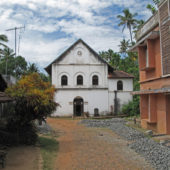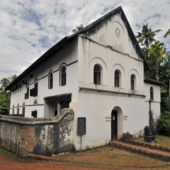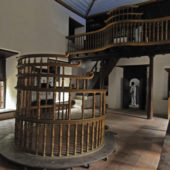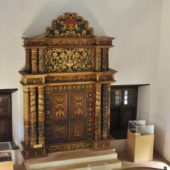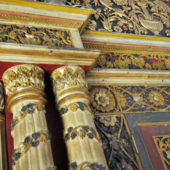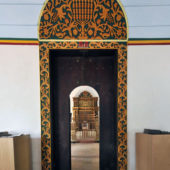The original synagogue on this site, built in 1614, has been replaced twice and restored in 2004. The building is a wonderful example of traditional thachusasthra design of the Kerala region.
The Jews of Cochin have lived along the Malabar coast for centuries, some say since the time of King Solomon. Others say they arrived after the first century, AD, following the destruction of the Second Temple. The oldest Hebrew text found in India, dated 1269, is found on a tombstone outside
Chennamanagalam Syangogue, in Cochin. Words are clearly inscribed which read, “Sara bat Israel” translated, Sara, the daughter of Israel. The Jews of Cochin follow the Sefardi liturgy, but pray according to the Shingly rite (according to the scholar P.T. Nair, the kingdom of Shingly is the part of Cranganore town, which is known as Kottapuran today).
In the Cochin Jewish Malayalam song, “The Song of Evarayi,” the migration of the Jews is traced from Jerusalem through Egypt, Yemen and Persia to Palur, north of Cranganore, and they finally settled in Chennamangalam. Then, according to the song, a Jewish man named Evarayi joined the aristocratic Nayars in a deer hunt, which is interpreted by some as signifying that the Jews were accepted as members of nobility. They lived peacefully with their neighbors for 350 years. All children went to Talmud school, which took place on the upper floor of the Synagogue. During the 20th century, Jewish children began attending high school outside of the village, and also attended university. The renowned playwright Dr. Pinhas ben Abraham Pallivathukal was born in this village and was the son of a cantor of the Synagogue.
In 1848 there were 164 Jews in Chennamanagalam, out of the total of 1344 Cochin Jews. By 1860 there were 30 families in Chennamanagalam and in 1950, the number of families had increased to 46. The village had been praying for Israel to become a nation. Therefore, when it did in 1948, the first group of 17 Jews from the village emigrated to Israel, followed by nearly all of the rest of the Jewish population, by the end of the 20th century. In the late 1990, when Kerala Govenor Babu Paul visited Israel, he came back and worked with organizations to renovate synagogues in India. The first to be restored was Chennamanagalam. The Department of Archaeology of Kerala undertook renovation of the Synagogue without damaging the original structure. It was dedicated in February of 2005. The Synagogue is now a protected monument under the State Department of Archaeology.
The Synagogue was built in 1614, during the Portuguese Inquisition. A high wall was built around it, although it is unclear whether this was to protect it or to mirror the Paliyam palace. Chennamanagalam Synagogue reflects traditional Thachusasthra architecture of the Kerala region, and has made use of western construction technology. The handsome white façade, features an A-frame roof and arched windows and doors. Inside the prayer room, the white walls are offset by dark woodwork, in the form of window frames, beautifully carved balcony with beautifully carved balusters and railings upstairs for the women’s gallery, as well as the lovely round bimah in the center of the sanctuary in a medium colored wood, featuring unusual five-tiered balusters with curved railings. Against the west wall is the majestic Aron Kodesh, which is intricately hand-carved and flanked with two-tiered double pilasters, hand-painted in beautiful colors and gilded. The high ceiling is decorated with a red-and-white checkerboard ceiling relief. Artwork is on display throughout the sanctuary. A few benches sit on the wood floors.
There is a Museum incorporated into the Synagogue. The Synagogue holds Sabbath and Holy Holiday services. It is open daily except for Mondays.

